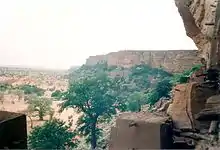Dogon country
Dogon country (French: Pays Dogon) is a region of Mali, Burkina Faso and Niger populated mainly by the Dogon people, a diverse ethnic group in West Africa with diverse languages. Like the term Serer country occupied by the Serer ethnic group, Dogon country is very vast, and lies southwest of the Niger River belt. The region is composed of three zones: the plateau, the escarpment and the Seno-Gondo plain.[1][2][3]

In Mali, this historic region belongs to the Mopti Region and extends on either side of the Bandiagara Escarpment. Dogon country in Mali is the most visited tourist area of the country, due to the Dogon people's rich cultural heritage.[2][3] Sangha, Mali is the heart of Dogon country with its reach history of Dogon religion, shrines and temples.[4][5]
Landscapes
Starting from the Niger River in a south-eastern direction, towards Burkina Faso, we successively meet three types of landscapes in Dogon country: plateau, cliff and plain.
Plateau
The region is a vast sandstone plateau rising gradually from the river to the cliff. It is on this plateau that Bandiagara, the “capital” of Dogon country is established.
Cliff
Its often almost vertical wall faces Burkina-Faso. With a height varying from 100 to around 400 m, it overlooks the Seno plain, which is between 250 and 300 m above sea level.
It is about 200 km long and oriented from southwest to northeast starting from Ségué in the south, and ending in Douentza in the north. The altitude increases from south to north until it reaches 791 m near Bamba, Koro.
It is the emblematic place of the country and its main center of tourist attraction.
Archeology
| Part of a series on |
| Traditional African religions |
|---|
 |
|
The Dogon country has many vestiges of ancient habitat from successive periods of occupation. From the ancient Toloy and Tellem, to the Dogon.[6]
There is the rocky channel located near Sangha where the remains of the Toloy were found, such as granaries, skeletons, pottery and plants, with a carbon-14 dating of 3rd and 2nd centuries BC.[6][7][8]
Religion and festivals
The Dogon religion is the traditional African beliefs of the Dogon of Mali. Those who follow this spiritual path believe in one Supreme Creator, Amma (or Ama[9]),[10][11] the omnipotent, omniscient and omnipresent Creator.[12]
They also believe in ancestral spirits such as the Serpent Ancestor Lebe, and the "Water Spirits" Nommo.[13] Veneration of the ancestors forms an important aspect of Dogon religion. They hold ritual mask dances immediately after the death of a person and sometimes long after they have passed on to the next life.[14] Twins, "the need for duality and the doubling of individual lives" (masculine and feminine principles) is a fundamental element in their belief system. Like other traditional African religions, balance, and reverence for nature are also key elements.[15] A lot of Dogons have also converted to Islam recently despite centuries of fleeing persecution and Islamization from other dominant communities.
Biological interests
The irregularities of the rocky plateau generate very high concentrations of water, which means that, beyond a typical Sahelian vegetation, extremely arid zones can rub shoulders with all kinds of lush green oases, pockets of extraordinary biodiversity.
Each microclimate in the region offers a unique assortment of medicinal plants and tree species with significant value for the population, such as shea, the locust bean, the acacia albida, the tamarind, African palmyra palm and the baobab.
Bird life
The Dogon country is known for its architecture and its rites, but it also has a rich bird life.[16]
Gallery
See also
References
- Dogon, Huib Blom (2010), pp.11, 18, (retrieved March 25, 2020) ISBN 9782839907255
- Velton, Ross, Mali: The Bradt Safari Guide, Bradt Travel Guides (2009), pp. 159, 187, ISBN 9781841622187 (retrieved March 25, 2020)
- Silverman, Raymond, Museum as Process: Translating Local and Global Knowledges, Routledge (2014), p. 189, ISBN 9781317661931 (retrieved March 25, 2020)
- United States. Department of State, Niger, Post Report, U.S. Department of State (1985), p. 13,
- St gelais, Remi; Landry, Denise; Mali : Culture mythique en pays Dogon à Youga Nah Falaise, Ulysse (2012), p. 6 ISBN 9782765805458 (retrieved March 25, 2020)
- Bedaux, Rogier Michiel Alphons, « Tellem, reconnaissance archéologique d'une culture de l'Ouest africain au Moyen Âge : recherches architectoniques », Journal de la Société des Africanistes (1974), #, p. 103–185 [in] Persée (retrieved March 15, 2020)
- photos & texte : Huib Blom, esquisses : Arian & Anneke Blom, p.2 (PDF) dogon-lobi.ch (retrieved March 15, 2020)
- Haour, Anne; Manning, K.; Arazi, N.; Gosselain, O.; African Pottery Roulettes Past and Present: Techniques, Identification and Distribution, Oxbow Books (2010), p. 3, ISBN 9781842178737 (retrieved March 25, 2020)
- Insoll, Timothy, Archaeology, Ritual, Religion, Routledge (2004), p. 123–125, ISBN 9781134526444 (retrieved March 3, 2020)
- Masolo (1994), pp. 70-71
- Temple, Robert, The Sirius Mystery, Random House (1999), p. 465, ISBN 9780099257448 (retrieved March 3, 2020)
- Hackett, Rosalind, Art and Religion in Africa, A&C Black 1(998), pp. 35-36, ISBN 9780826436559 (retrieved March 3, 2020)
-
- Griaule, Marcel (1970, (original 1965)), Conversations With Ogotemmêli: an Introduction To Dogon Religious Ideas , p. 97, ISBN 978-0-19-519821-8
- Davis, Shawn R., Dogon Funerals [in] African Art, vol. 35, Issue 2, JSTOR (Organization), University of California, Los Angeles. African Studies Center, African Studies Center, University of California, Los Angeles (2002), p. 68
- Griaule, Marcel (1970, (original 1965)), Conversations With Ogotemmêli: an Introduction To Dogon Religious Ideas , p. 198, ISBN 978-0-19-519821-8
- "Pays Dogon", « La nature et biodiversité » [in] Dogoncountry.com (retrieved 25-03-2020
Further reading
- Ballo, Mamadou, Cultural Impacts of Tourism: The Case of the 'Dogon Country' in Mali, Rochester Institute of Technology (2011)



.JPG.webp)
.JPG.webp)
.JPG.webp)
